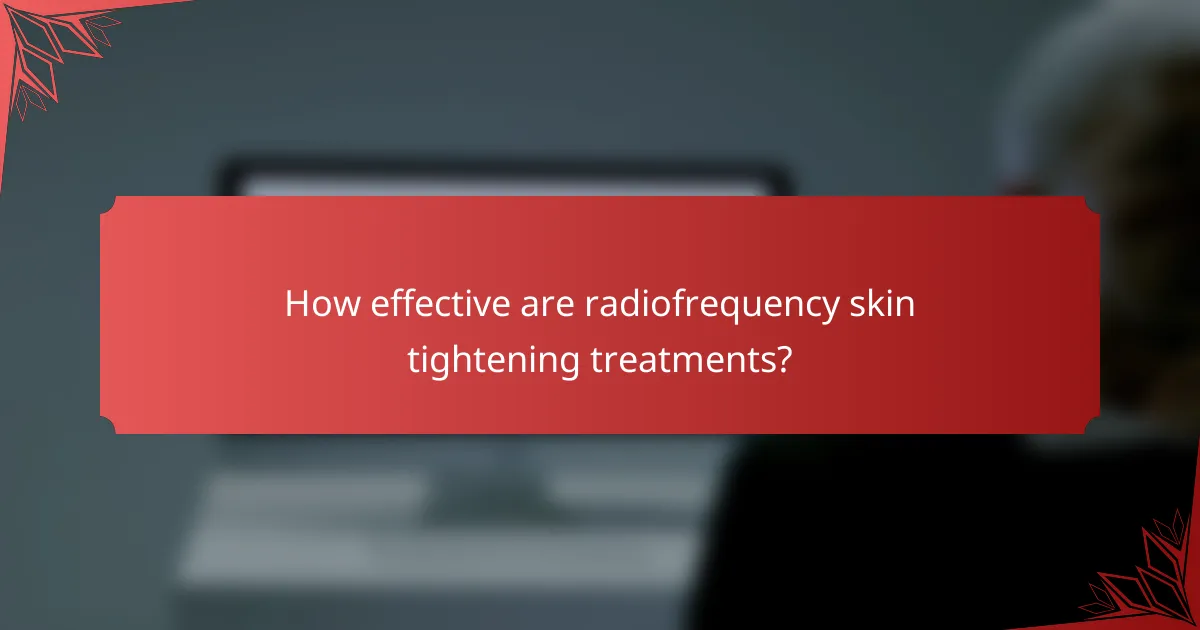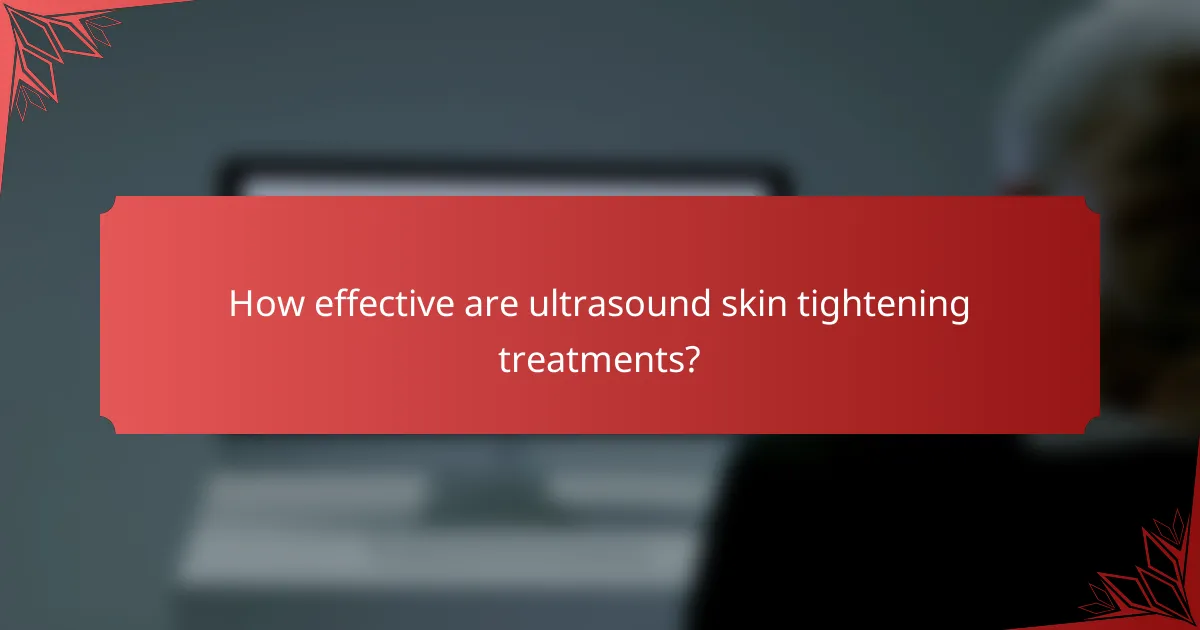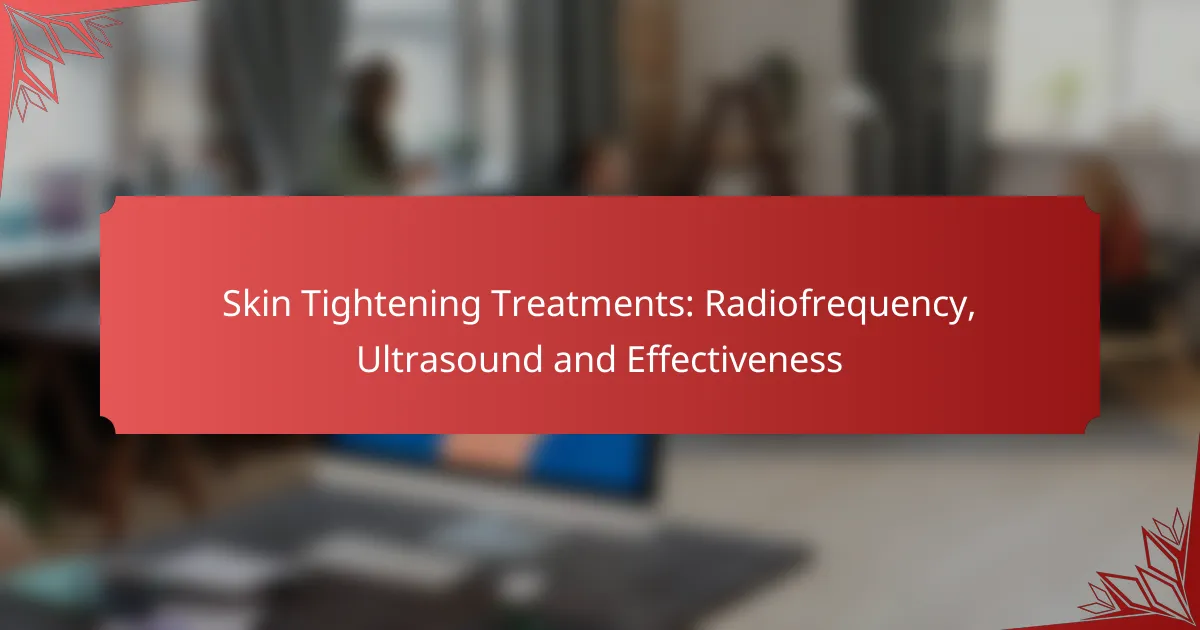Skin tightening treatments such as radiofrequency and ultrasound offer effective solutions for improving skin laxity and stimulating collagen production. These methods vary in effectiveness, cost, and recovery time, allowing individuals to select the best option based on their unique needs. Many patients experience noticeable results after a series of sessions, making these treatments popular choices for those seeking firmer skin.

What are the best skin tightening treatments in South Africa?
The best skin tightening treatments in South Africa include radiofrequency, ultrasound, laser skin tightening, microneedling with RF, and combination therapies. These options vary in effectiveness, cost, and recovery time, allowing individuals to choose based on their specific needs and preferences.
Radiofrequency treatments
Radiofrequency (RF) treatments use energy to heat the deeper layers of the skin, stimulating collagen production and promoting tighter skin. This non-invasive procedure typically requires multiple sessions, with noticeable results often seen after a few weeks.
In South Africa, RF treatments can cost between ZAR 1,500 to ZAR 5,000 per session, depending on the clinic and the area being treated. It’s essential to consult with a qualified practitioner to determine the best approach for your skin type.
Ultrasound treatments
Ultrasound treatments employ sound waves to penetrate the skin and stimulate collagen production, leading to tighter skin over time. This method is known for its precision, targeting specific areas without affecting surrounding tissues.
Sessions typically last around 30 to 90 minutes, and patients may see improvements gradually over a few months. In South Africa, the cost usually ranges from ZAR 3,000 to ZAR 8,000 per session, making it a more premium option.
Laser skin tightening
Laser skin tightening utilizes focused light energy to heat the skin, promoting collagen remodeling and skin tightening. This method can effectively treat various skin types and is often chosen for its quick recovery time.
In South Africa, laser treatments can vary widely in price, generally falling between ZAR 2,500 and ZAR 7,000 per session. It’s crucial to ensure that the procedure is performed by a certified professional to minimize risks.
Microneedling with RF
Microneedling with RF combines traditional microneedling with radiofrequency energy, enhancing collagen production while improving skin texture. This dual approach can lead to more significant tightening effects compared to either treatment alone.
Sessions may take about 60 to 120 minutes, with results becoming visible after a few weeks. In South Africa, the cost typically ranges from ZAR 3,500 to ZAR 10,000 per session, reflecting its advanced nature.
Combination therapies
Combination therapies involve using two or more skin tightening methods to maximize results. For example, pairing RF with ultrasound can enhance collagen stimulation and improve overall skin quality.
These therapies are tailored to individual needs, often requiring a consultation to determine the best combination. Pricing in South Africa can vary significantly, generally starting from ZAR 5,000 and going up depending on the treatments involved.

How effective are radiofrequency skin tightening treatments?
Radiofrequency skin tightening treatments are generally effective for improving skin laxity and promoting collagen production. Results can vary based on individual skin types, treatment settings, and the specific technology used.
Clinical studies on effectiveness
Numerous clinical studies have demonstrated that radiofrequency treatments can lead to noticeable improvements in skin tightness and texture. Research typically shows that patients experience a moderate to significant reduction in sagging skin after a series of sessions, often ranging from three to six treatments spaced a few weeks apart.
These studies often measure effectiveness through objective assessments and patient-reported outcomes, confirming that radiofrequency can stimulate collagen and elastin production, which are crucial for maintaining skin firmness.
Patient satisfaction rates
Patient satisfaction rates for radiofrequency skin tightening treatments are generally high, with many reporting visible improvements in their skin’s appearance. Surveys indicate that satisfaction can range from 70% to over 90%, depending on the individual’s expectations and the treatment protocol followed.
Factors influencing satisfaction include the skill of the practitioner, the technology used, and the patient’s skin condition prior to treatment. Clear communication about expected outcomes can enhance overall satisfaction.
Duration of results
The results of radiofrequency skin tightening treatments can last anywhere from six months to two years, depending on various factors such as skin type, age, and lifestyle. Maintenance treatments are often recommended to prolong the effects.
Patients can expect gradual improvements over time, with optimal results typically visible a few months after the final session. Regular follow-ups can help maintain skin firmness and address any changes as the skin ages.

How effective are ultrasound skin tightening treatments?
Ultrasound skin tightening treatments are generally effective for improving skin laxity and promoting collagen production. Results can vary based on individual skin types and treatment protocols, but many patients report noticeable tightening after a series of sessions.
Mechanism of action
Ultrasound skin tightening works by delivering focused ultrasound energy to the deeper layers of the skin, stimulating collagen production and tightening the tissue. This non-invasive approach heats the dermis without damaging the outer layer, promoting natural healing processes.
The treatment typically involves the use of a handheld device that emits ultrasound waves, which penetrate the skin at specific depths. This targeted energy causes controlled thermal injury, triggering the body’s repair mechanisms to produce new collagen over time.
Clinical outcomes
Clinical studies indicate that ultrasound skin tightening can lead to significant improvements in skin firmness and elasticity. Many patients experience visible results within a few months, with optimal effects often seen after multiple sessions.
Results can last for several months to a year, depending on individual factors such as age, skin condition, and lifestyle. Regular maintenance treatments may be recommended to sustain the effects over time.
Comparison with radiofrequency
When comparing ultrasound to radiofrequency skin tightening, both methods aim to stimulate collagen but use different energy sources. Ultrasound targets deeper layers more precisely, while radiofrequency typically affects both the dermis and epidermis.
Ultrasound may offer quicker treatment times and less discomfort for some patients, while radiofrequency can provide a broader range of skin tightening effects. Ultimately, the choice between the two should consider individual skin needs and desired outcomes.

What factors influence the effectiveness of skin tightening treatments?
The effectiveness of skin tightening treatments is influenced by several factors, including skin type, age, and the frequency of treatments. Understanding these elements can help individuals achieve better results from procedures like radiofrequency and ultrasound therapies.
Skin type and condition
Different skin types respond variably to skin tightening treatments. For instance, individuals with thicker skin may experience more noticeable results compared to those with thinner skin. Additionally, pre-existing skin conditions, such as acne or rosacea, can affect treatment outcomes and may require tailored approaches.
It’s crucial to consult with a qualified practitioner who can assess your skin type and condition before proceeding with any treatment. This ensures that the chosen method aligns with your skin’s unique needs, maximizing effectiveness.
Age and elasticity
Age significantly impacts skin elasticity, which is a key factor in the success of tightening treatments. As people age, collagen production decreases, leading to sagging skin. Younger individuals often have more elastic skin, which can respond better to treatments.
For optimal results, those in their 30s and 40s may see significant improvements, while older individuals may require more sessions or a combination of treatments to achieve similar effects. Understanding your age-related skin changes can guide treatment choices.
Frequency of treatments
The frequency of skin tightening treatments plays a vital role in achieving desired results. Regular sessions can enhance the cumulative effects of the treatment, leading to more pronounced tightening over time. Many practitioners recommend a series of treatments spaced a few weeks apart for optimal outcomes.
However, it’s essential to follow the advice of your healthcare provider regarding treatment frequency. Overdoing it can lead to skin irritation or other complications, while under-treating may not yield the expected benefits. A balanced approach is key to effective skin tightening.

What are the costs of skin tightening treatments in South Africa?
The costs of skin tightening treatments in South Africa can vary significantly based on the type of treatment and the provider. Generally, patients can expect to pay anywhere from a few thousand to over ten thousand rand per session, depending on the technology used and the treatment area.
Average pricing for radiofrequency
Radiofrequency skin tightening treatments typically range from 2,500 to 8,000 rand per session. The price may depend on factors such as the size of the treatment area and the clinic’s reputation. Multiple sessions are often recommended for optimal results, which can increase the overall cost.
When considering radiofrequency treatments, it’s essential to inquire about package deals or discounts for multiple sessions. Some clinics may offer promotional rates that can help reduce the total expenditure.
Average pricing for ultrasound
Ultrasound skin tightening treatments generally cost between 3,000 and 10,000 rand per session. Similar to radiofrequency, the final price can vary based on the treatment area and the expertise of the practitioner. Patients should also consider the potential need for follow-up sessions to maintain results.
Before committing to ultrasound treatments, it’s advisable to compare prices among different clinics and ask about any available financing options. This can help ensure you receive quality care without exceeding your budget.
